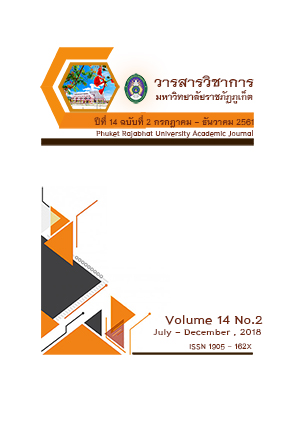การพัฒนาเทคนิคการประเมินการคิดวิเคราะห์ทางวิทยาศาสตร์ของผู้เรียน ด้วยการสร้างโมเดลภาวะสันนิษฐานทางทฤษฎีและการวัดแบบราสช์
Main Article Content
บทคัดย่อ
The purposes of this study aimed to develop techniques for assessing students’ analytical thinking in science using construct mapping and Rasch measurement, to create test items for assessing students’ analytic thinking in science, and to evaluate the effectiveness of the techniques for assessing students’ analytic thinking in science. The sample was three hundred Grade 7 students in Kamphaengphet province and under the Office of the 41st Educational Service Area. The study began by creating and validating the construct maps of students’ analytic thinking in science with student responses, then creating 4-option items for measuring the grade 7 students’ analytical thinking in science. Each option was scored differently.
The results are shown as follows: The construct map of students’ analytical thinking in science consisted of four ability levels (Beginning, Basic, Proficient, and Advanced) and two dimensions (the Justification dimension which consisted of Perception, Reasoning, Explaining, and Summarizing levels and the Application dimension which consisted of Remembering, Complying, Applying, and Advanced Applying levels). The test consisted of 36 items. The test passed the criteria of the expert judgment index and the similarity index at .80. Cronbach alpha coefficient was .74 . The EAP/PV reliability was .74. Infit MNSQ statistics fell within the acceptable range of .75 to 1.33. Split-half reliabilities computed from odd and even items was .78 and first and second half items was at .49.
The assumed theoretical construct map showed its criterion zones of the estimated abilities (θ) as below -.52, -.52 - .06 , .07 – .50, above .50
Article Details
เนื้อหาและข้อมูลในบทความที่ลงตีพิมพ์ในวารสารวิชาการมหาวิทยาลัยราชภัฏภูเก็ต ถือเป็นข้อคิดเห็นและความรับผิดชอบของผู้เขียนบทความโดยตรง ซึ่งกองบรรณาธิการวารสารฯ ไม่จำเป็นต้องเห็นด้วยหรือร่วมรับผิดชอบใด ๆ
บทความ ข้อมูล เนื้อหา รูปภาพ ฯลฯ ที่ได้รับการตีพิมพ์ในวารสารวิชาการมหาวิทยาลัยราชภัฏภูเก็ต ถือเป็นลิขสิทธิ์ของวารสารวิชาการมหาวิทยาลัยราชภัฏภูเก็ต หากบุคคลหรือหน่วยงานใดต้องการนำทั้งหมดหรือส่วนหนึ่งส่วนใดไปเผยแพร่ต่อหรือเพื่อกระทำการใด ๆ จะต้องได้รับอนุญาตเป็นลายลักษณ์อักษรจากวารสารวิชาการมหาวิทยาลัยราชภัฏภูเก็ตก่อนเท่านั้น
เอกสารอ้างอิง
กระทรวงศึกษาธิการ. (2555).แนวทางการจัดกิจกรรมการเรียนรู้เพื่อพัฒนาทักษะการคิด ตามหลักสูตรแกนกลางการศึกษาขั้นพื้นฐาน พุทธศักราช 2551 กลุ่มสาระการเรียนรู้วิทยาศาสตร์ระดับมัธยมศึกษา. กรุงเทพฯ : โรงพิมพ์ชุมนุมสหกรณ์การเกษตรแห่งประเทศไทย.
เกรียงศักดิ์ เจริญวงศ์ศักดิ์.(2546).ภาพอนาคตและคุณลักษณะของคนไทยที่พึงประสงค์. กรุงเทพฯ : สำนักงานคณะกรรมการการศึกษาแห่งชาติ.
มารุต พัฒผล. (2557).การจัดการเรียนรู้ที่เสริมสร้างการรู้คิดและความสุขในการเรียนรู้. กรุงเทพฯ : จรัลสนิทวงศ์การพิมพ์.
ปริญญา กาลายศ. (2556).การพัฒนาแบบวัดความสามารถในการคิดวิเคราะห์ สำหรับนักเรียนชั้นมัธยมศึกษาปีที่ 3 สังกัดสำนักงานเขตพื้นที่ การศึกษามัธยมศึกษากรุงเทพมหานคร เขต 2. วิทยานิพนธ์ปริญญา ศึกษาศาสตรมหาบัณทิต (วิจัยและประเมินผลการศึกษา). มหาวิทยาลัยเกษตรศาสตร์.
ประพันธ์ศิริ สุเสารัจ. (2548). สอนอย่างไรให้คิดเป็น. กรุงเทพฯ : วัฒนาพาณิช.
วีรภัทร์ สุขศิริ. (2557). การสร้างแผนที่ตัวแปรเชิงทฤษฎี : แนวทางการสร้างโมเดลความคิดในระบบการประเมินที่ถูกต้องและน่าเชื่อถือ. วารสารวิจัยและพัฒนาหลักสูตร, 4(1), 46-66.
สมเกียรติ พรพิสุทธิมาศ.(2556). การจัดการเรียนรู้วิทยาศาสตร์ในศตวรรษที่ 21. หน่วยวิจัยวิทยาศาสตร์เทคโนโลยี และสิ่งแวดล้อมเพื่อการเรียนรู้. 4(1) 55-63.
อมรวิชช์ นาครทรรพ. (2559). ความฝันของแผ่นดิน. กรุงเทพฯ : โรงพิมพ์ตะวันออก.
Adams, R. J., & Khoo, S-T. (1996).Quest: The interactive test analysis system. Camberwell, Australia : Australian Council for Educationak Research.
Anderson, L. W., & Krathwohl, D. R. (2001). A taxonomy for learning, teaching, and assessing: A revision of Bloom’s taxonomy of educational objectives. New York : Addison Wesley Longman.
Brown, N., & Wilson, M. (2011). A model of cognition: The missing cornerstone of assessment. Educational Psychological Review, 23(2), 221-234.
Bloom, B . (1956). Taxonomy of education objectives handbook I: Cognitive domain. New York : David McKay Company.
Cronbach, L. J. (1990). Essentials of psychological testing. (5th ed). New York : Harper Collins Publishers.
Engelhard, George Jr.; & Myford, Carrol M.(2003).Monitoring Faculty Consultant Performance In the Advance Placement English literature and Composition Program with Many Faceted Rasch Model. USA : College Entrance Examination Board.
Marzano, R, J. (2001).Desinging a new taxonomy of educational objectives. California : Corwin Press.
Mislevy, R. J. (1996).Test theory reconceived.Journal of Educational Measurement, 33(4), 379-416.
National Research Council (2001). Knowing what students know: The science and design of educational assessment.Committee on the Foundations of Assessment. J. Pellegrino, N. Chudowsky, & R. Glaser (Eds). Washington, DC: National Academy Press.
Nunnally, J. (1967). Psychometric methods. New York : McGraw-Hill Book Co.
Schiever, Shirly W. (1991). A Comprehensive Approach to Teaching Thinking. Boston : Allyn and Bacon.
Smith, R. M., Schumacker, R. E., & Busch, M. J. (1995). Using item mean squares to evaluate fit to the Rasch model. Paper presented at the annual meeting of the American Educational Research Association. San Francisco, CA.
Stetrnberg, Robert J.(1997).Thinking styles cambridge : Cambridge University Press.
William J. Boone.(2016).Rasch Analysis for Instrument Development : Why,When, and How ?. CBE life sciences education, 15(4), rm4
Wilson, M. (2005). Constructing measures: An item response modeling approach. Mahwah, NJ: Erlbaum.
Wilson, M., Bejar, I., Scalise, K., Templin, J., William, D., & Irribarra, D. T. (2012). Perspectives on methodological issues. In P. Griffin, B. McGaw, & E. Care (Eds.), Assessment and teaching of 21st-century skills (pp. 67-141). New York, NY: Springer.
Wright, B. D., Mead, R. J., & Bell, S. R. (1980).BICAL : Calibrating items with the Rasch model. Chicago, IL: Research Memorandum.
Zeichner, K.& Liston, D. (1987). Teaching student teachers to reflect. Harvard Educational Review, 57(1), 23-48.


